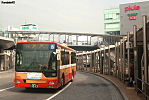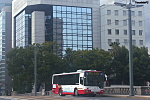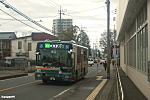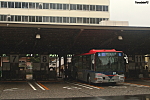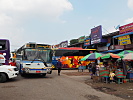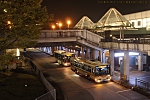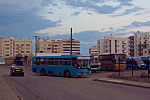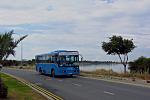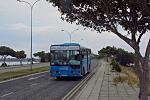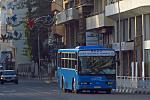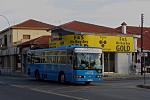Not logged in | Log in | Sign Up

Search Photos
Mitsubishi Fuso Aero Star #6286
15 february 2019 - Himeji (Hyōgo Pref.), Ekimaechō (兵庫県姫路市駅前町), bus terminal area outside Himeji station.39: 姫路駅北口 (Himeji Station North Exit) → 龍野 (Tatsuno)
Today`s very random series is not motivated by location, but by bus type. Mitsubishi Fusō Aero Star is after all a rather rare model amongst Japanese city bus operators in recent years - given that the market is dominated by Isuzu Erga slash Hino Blue Ribbon (they`re the same thing...). Meanwhile this manufacturer will appear in Tōkyō (or rather in the state operations) for the first time in eight years, given its winning of a tender for supply of 140 buses. Other operators around Tōkyō don`t have the model seen in the photo in large quanities either (Tōbu doesn`t seem to have anything, the other major operators in rather small numbers), so this series is primarily from outside of the capital.


Author: TranslatorPS 

Mitsubishi Fuso Aero Star #547
14 february 2019 - Hiroshima (Hiroshima Pref.), Inari-ōhashi (広島県広島市稲荷大橋).25: 井口車庫 (Inokuchi Depot) → 広島駅 (Hiroshima Station)
Headlight frames painted like in a Lion`s City - the topic of the livery is one of many floating around now that the Tōkyō metropolitan government has announced the winner of the tender to supply 140 diesel-powered buses to be Mitsubishi Fusō. The titular company first offered its buses for 2,506,000,000 yen, so around 19.9 mln euro, or 142,350 euro per unit. Somehow however, through some sort of sorcery, their winning price was 2,756,600,000 yen, coming to around 156,600 euro per bus.
There will still be plenty of opportunities to discuss the bus side of Hiroshima.


Author: TranslatorPS 

Mitsubishi Fuso Aero Star #A5-829
13 december 2018 - Niiza (Saitama Pref.), Higashi 3-chōme (埼玉県新座市東3丁目), Prefectural Route 40.清61 (kiyo-61): 志木駅南口 (Shiki Station South Exit) → 清瀬駅北口 (Kiyose Station North Exit)
The yellow tactile tiles seen in the sidewalk leads to more or less where the bus should stop at the barely visible Rikkyō-mae stop. The route in the photo, 清61 (kiyo-61), is one of the numerous bus connections criss-crossing the primarily east-west railway network and connecting the various train stations. These routes however primarily serve as feeders to the nearest station as opposed to connecting the railway lines.


Author: TranslatorPS 

Mitsubishi Fuso Aero Star #H1026-M
30 december 2018 - Niigata (Niigata Pref.), Chūō-ku, Hanazono 1-chōme (新潟県新潟市中央区花園1丁目), Niigata-eki-mae bus terminal stands.E22: 新潟駅前 (Niigata Station) → 新潟空港 (Niigata Airport)
Stand no. 9, occupied by the Mitsubishi Fusō, is dedicated entirely to E2x routes. The airport bus, E22, is the shortest route alongside E21 out of all twelve routes on this corridor. Aside from rte E22 and its rather uninspiring schedule (every 30-70 minutes Mon-Fri and every 50-60 Sat&Sun) and a price tag of 420 yen, there is also an "airport limousine" for the same price, but non-stop and much more frequently (every 20-40 minutes every day with some gaps). Personally I didn`t have to use it - I arrived in Niigata on the Shinkansen - but it`s interesting to see the airport connections compared to some European cities, especially those smaller than Niigata. In terms of impressive frequency one has to see the entire E2x corridor, where E22 amounts to barely anything.


Author: TranslatorPS 

Comments: 2
Mitsubishi Fuso Aero Star #H1208-M
30 december 2018 - Niigata (Niigata Pref.), Chūō-ku, Nishiboridōri 5-banchō (新潟県新潟市中央区西堀通5番町), National Route 116.W10: 新潟駅前 (Niigata Station) → 内野営業所 (Uchino Depot)
The W1x corridor operates every 15 minutes Mon-Fri and every 20 minutes Sat&Sun for most of the day (with higher frequencies in the peaks of course). However, there is a clear lack of pattern as to which route will operate - during daytime there is more W11 trips, but during the peaks there`s more W10s. I can still respect them sticking to a frequency on the corridor though.


Author: TranslatorPS 

Mitsubishi Fuso Aero Star #BGO 7B-7921
16 october 2018 - Aung Mingalar Highway Bus Station. The bus station is also in fact a big market for food and beverages and other items. The ordinary Burmese has no financial possibility of using domestic air planes, and the inter-urban bus routes are the only alternative. The buses are frequently several hours on their way to the destination.
Comments: 2
Mitsubishi Fuso Aero Star #TKQM427
21 april 2013 - Λάρνακα, Δήμητρας (Κεντρικός Σταθμός), linia 418Japończyk wjeżdża na teren obiektu nazwanego dumnie "dworcem centralnym", z którego wrzucę teraz małą serię zdjęć. W praktyce jest to kawał ogrodzonego błotnistego placyku, z budką i mnóstwem odstawionych dziwacznych pojazdów, pamiętających inne czasy. Typowe dla tej wyspy i jakże klimatyczne...

Author: fafax 

Place: Λάρνακα (Lárnaka) (Λάρνακα (Lárnaka))
| Owner: Ζήνωνας Λάρνακα (Lárnaka) | Transport Authority: ΤΟΜ | Route: 418
Mitsubishi Fuso Aero Star #TKQM427
19 april 2013 - Λάρνακα, Αρτέμιδος (Lárnaka, Artémidos), γραμμή 418
Author: fafax 

Place: Λάρνακα (Lárnaka) (Λάρνακα (Lárnaka))
| Owner: Ζήνωνας Λάρνακα (Lárnaka) | Transport Authority: ΤΟΜ | Route: 418
Mitsubishi Fuso Aero Star #TKQM427
19 april 2013 - Λάρνακα, Αρτέμιδος, γραμμή 418
Author: fafax 

Place: Λάρνακα (Lárnaka) (Λάρνακα (Lárnaka))
| Owner: Ζήνωνας Λάρνακα (Lárnaka) | Transport Authority: ΤΟΜ | Route: 418
Mitsubishi Fuso Aero Star #TKQM427
1 december 2012 - Λάρνακα, Αρχιεπισκόπου Μακαρίου ΄Γ [Lárnaka, Archiepiskópou Makaríou III], δρομολόγιο 418
Author: fafax 

Place: Λάρνακα (Lárnaka) (Λάρνακα (Lárnaka))
| Owner: Ζήνωνας Λάρνακα (Lárnaka) | Transport Authority: ΤΟΜ | Route: 418
Mitsubishi Fuso Aero Star #TKQM427
1 december 2012 - Λάρνακα, Αρχιεπισκόπου Μακαρίου ΄Γ, δρομολόγιο 418
Author: fafax 

Place: Λάρνακα (Lárnaka) (Λάρνακα (Lárnaka))
| Owner: Ζήνωνας Λάρνακα (Lárnaka) | Transport Authority: ΤΟΜ | Route: 418
